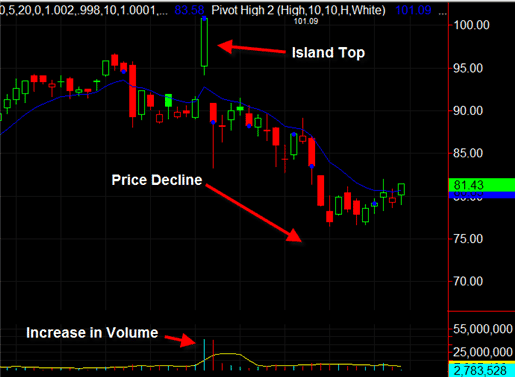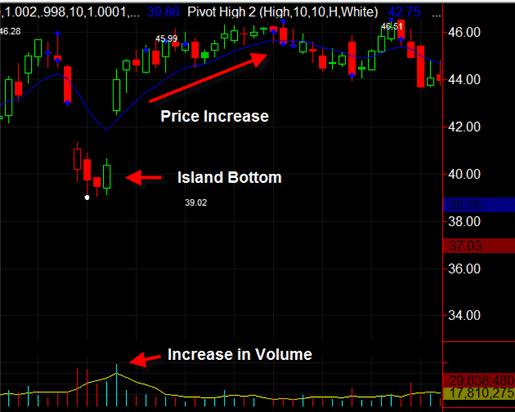To practice the island reversal examples detailed in this article visit http://tradingsim.com.
Island Reversal – Reversal Candlestick Pattern
An island reversal is a chart formation where there is a gap on both sides of the candle. Island reversals frequently show up after a trending move is in its final stages. An island reversal gets it name from the fact that the candlestick appears to be all alone, as if on an island. A key sign of a valid island reversal is an increase on volume on both the first gap, and then the subsequent gap in the opposite direction. An island reversal formation is often attributed to news driven events that occur in the pre-market or after-hours trading.
Island Top

Island Bottom

As you can see a bearish signal is the island top. All of the buyers are left hanging with zero time to react to the selloff.
Conversely, an island bottom can create the squeeze required to start a new uptrend.
Trading the Island Reversal Stock Pattern
Now that you are familiar with the two Island reversal chart patterns, let’s walk through how to trade the setup.
#1 – Entering an Island Reversal Trade
In order to confirm the Island candle pattern, you should discover three symptoms on the chart:
- The stock gaps in a bearish or bullish direction.
- After at least the close of one candle, the stock gaps back in the opposite direction.
- None of the candles from the island overlaps with the candles from the general price action, including the body or the candle wick.

See that the price action above starts with a bearish move. Suddenly, a bearish gap appears on the chart separating the price action. Three candles later we see an opposite bullish gap. None of the candles from the formed Island overlaps with the price action.
This way we confirm the authenticity of the candle pattern. You can go long with the opening of the first candle after the second gap as shown on the image.
When you find these three signs on the chart, you have confirmed the pattern.
#2 – Island Reversal Pattern Target
In order to find the size of the pattern you need to measure the distance between the lowest candle of the general price action and the lowest candle of the Island pattern.

The first rectangle above illustrates the size of the pattern. The two black arrows show the lowest point of the general price action and the lowest point of the Island pattern. We have built the rectangle based on these two points.
After we create the rectangle, we apply the height to the beginning of the candle after the second gap. This way the top of the rectangle provides the minimum target for the island pattern.
After reaching the minimum target, you can always extend your target based on the price action. You can find a support level and place your stop beneath this level.
You can then stay in the trade until you see three candles go against you or the support area is broken.
If the stock keeps trending in your favor, you should keep adjusting the stop upwards.
#3 – Stop Loss with the Island Reversal
When you spot the pattern and you open a trade, you need to immediately place a stop loss. The proper location of the stop is below the lowest point of the pattern (island bottom). This way you will be protected in case the price goes contrary to your trade and overlaps with the pattern.

Since the stop is below the pattern and you trade the size of the pattern, the win-loss ratio is based on the minimum target (0.9 : 1).
This is absolutely acceptable since the pattern has a high success rate.
We should discuss one more case here. If you decide to extend the target of your trade, you should apply additional stop loss management rules. In case the price keeps increasing, you should constantly adjust your stop loss in the direction of the price increase.
Full Island Candlestick Pattern Strategy

Above you see the 1-minute chart of Ford from February 24, 2016.
The image above starts with a bearish decline.
After the bearish gap, we see that the price action completes three candles separately. When the three candles are completed, the price action creates a bullish gap, which is opposite to the bearish pattern.
At the same time, there are no overlapping elements between the price action. Therefore, we confirm the presence of an authentic island bottom candlestick pattern on the chart (black arrow).
We buy Ford based on the island bottom formation and place a stop loss right below the low of the formation.
The next step we take is to measure the size of the formation. The first blue arrow on the chart takes the lowest point of the island pattern and the lowest point of the price action around the pattern. Now we have the size of the Island figure. We apply this size starting from the moment of confirmation and our respective entry point. The blue arrow illustrates the minimum target for the setup.
7 minutes after we go long with Ford, the price completes the minimum target on the pattern. See that there is a correction of the bullish move before the target was completed. However, the contrary move doesn’t reach our stop loss order and we stay in the trade.
When the target is reached, we can close our trade. However, we also have the option to stay in the trade and extend our target. In case you decide to do this you would need to adjust your stop loss. See the bottom that comes right after the target was completed. This looks like a proper location for our adjusted stop loss order (Stop Loss 2).
A new price boost comes afterwards and our gains are extended nearly twice. However, a big correction brings the price in the area of our adjusted stop loss order. See that the price makes three attempts to break the bottom; however, our stop loss order is properly placed and contains the price action.
After the three tests at $11.92, the price has a strong rally, which nearly triples the gains from the minimum target.
Right after the bullish candle, the price action closes three bearish candles in a row. This gives us an exit signal from our trade and we close our Ford trade.
Conclusion
- The Island candle pattern consists of one or few candles, surrounded by gaps from both sides.
- The gaps need to be opposite to each other so the candles will look like a separate island above or below the price action.
- There are two types of Island candle patterns:
- Island Top – when the pattern is above the price action
- Island Bottom – when the pattern is below the price action
- In order to confirm an Island pattern and to enter a trade you need to find three symptoms on the chart:
- The stock creates a gap.
- Few candles later the stock gaps in the opposite direction.
- The separated candles do not overlap with the price action.
- The minimum target of the pattern equals its size.
- A stop loss should be settled below the island pattern when entering a trade.
- The target could be extended to a situation where you find three opposite candles. In this case you should always adjust your stop loss based on simple price action rules.


its woring very fine it patten gives result of 10 % in iladn top but 5-8% retun in iland bottom formation
regards
d.nagaraju
its workin very fine it patten gives result of 10 % in iladn top but 5-8% retun in iland bottom formationregardsd.nagaraju